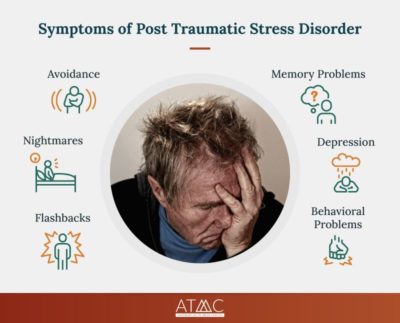Symptoms of PTSD

The symptoms of PTSD can vary over time when it comes to intensity. They can become more intense when the person is under general stress. Or, the person can be reminded of the traumatizing event by an everyday occurrence that seems similar. A car backfiring, for example, can be a trigger.
PTSD symptoms may increase with age, even occurring 50 years or more after the initial wartime event, for a number of reasons.
Retirement can increase symptoms by giving veterans more time to think about the past with fewer distractions. Plus, increased medical problems may make them feel less strong.
Some veterans who’ve used alcohol or other substances to cope in the past stop and become sober. If they are no longer able to become intoxicated because of health issues or for other reasons, they may find PTSD symptoms worsen.
What kind of symptoms might they experience?
They fall into three general categories: reliving the trauma; avoiding situations that can trigger memories of the event; and a highly irritable, anxious state.
-
- Flashbacks — There are several types of flashbacks. In visual flashbacks, you feel like you’re transported back to the moment of trauma and are going through it all over again. Somatic flashbacks trigger pain and discomfort in areas affected by the trauma. Emotional flashbacks cause intense, often irrational feelings.
- Nightmares — PTSD survivors are far more likely to experience nightmares. One study found that 52% of combat veterans with PTSD who served in Vietnam had nightmares fairly frequently. Meanwhile, only 3% of civilians reported comparable levels of nightmares. Some PTSD survivors may experience nightmares several times a week.
- Avoidance — PTSD survivors may attempt to cope by avoiding triggering situations or even avoiding the feelings themselves. But avoidance may make the symptoms even worse.
- Memory problems — Memory loss and trouble concentrating are common symptoms of PTSD. This is of concern because memory problems can impact a patient’s ability to respond to, and take part in, psychological treatment.
- Behavioral problems — Self-destructive behavior and irritability or aggression are among the behavioral problems associated with PTSD. They also are called arousal symptoms.
- Depression — About half of those affected by PTSD also suffer from major depressive disorder. This can create further challenges because those who have both disorders are more likely to drop out of treatment.
